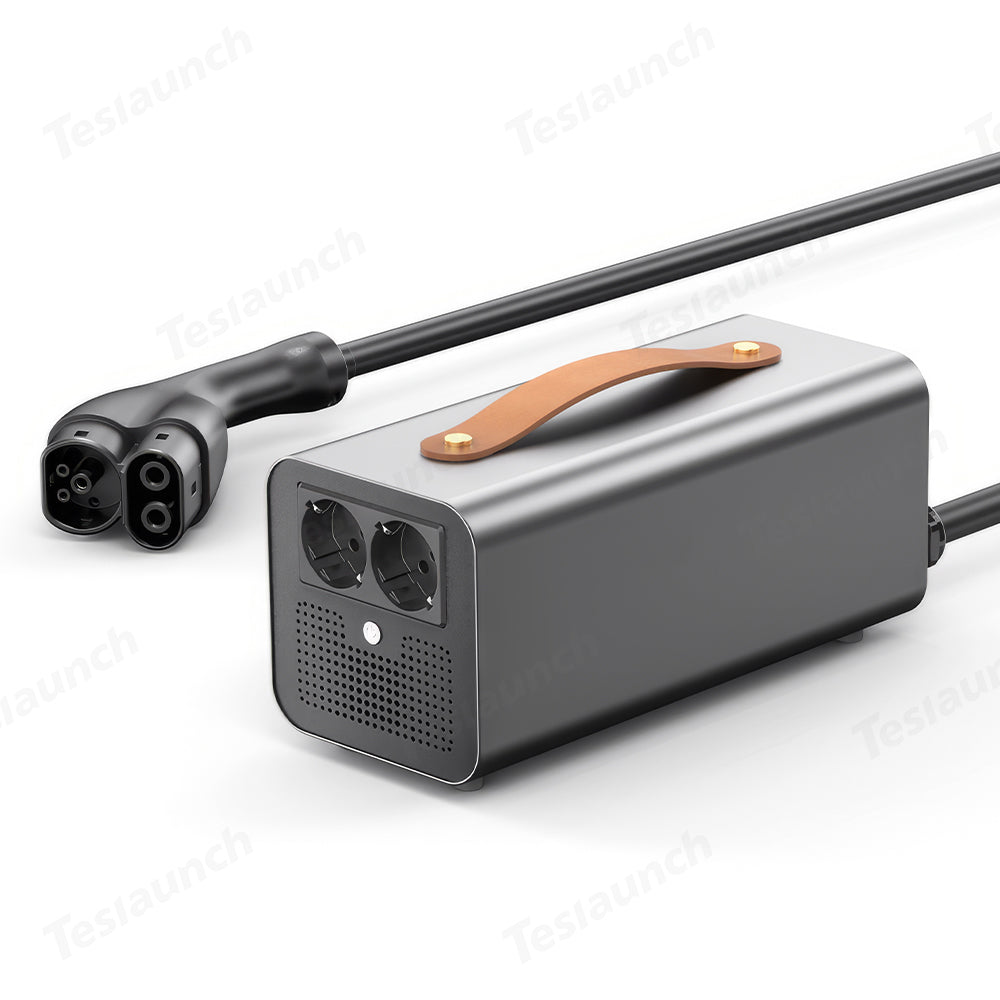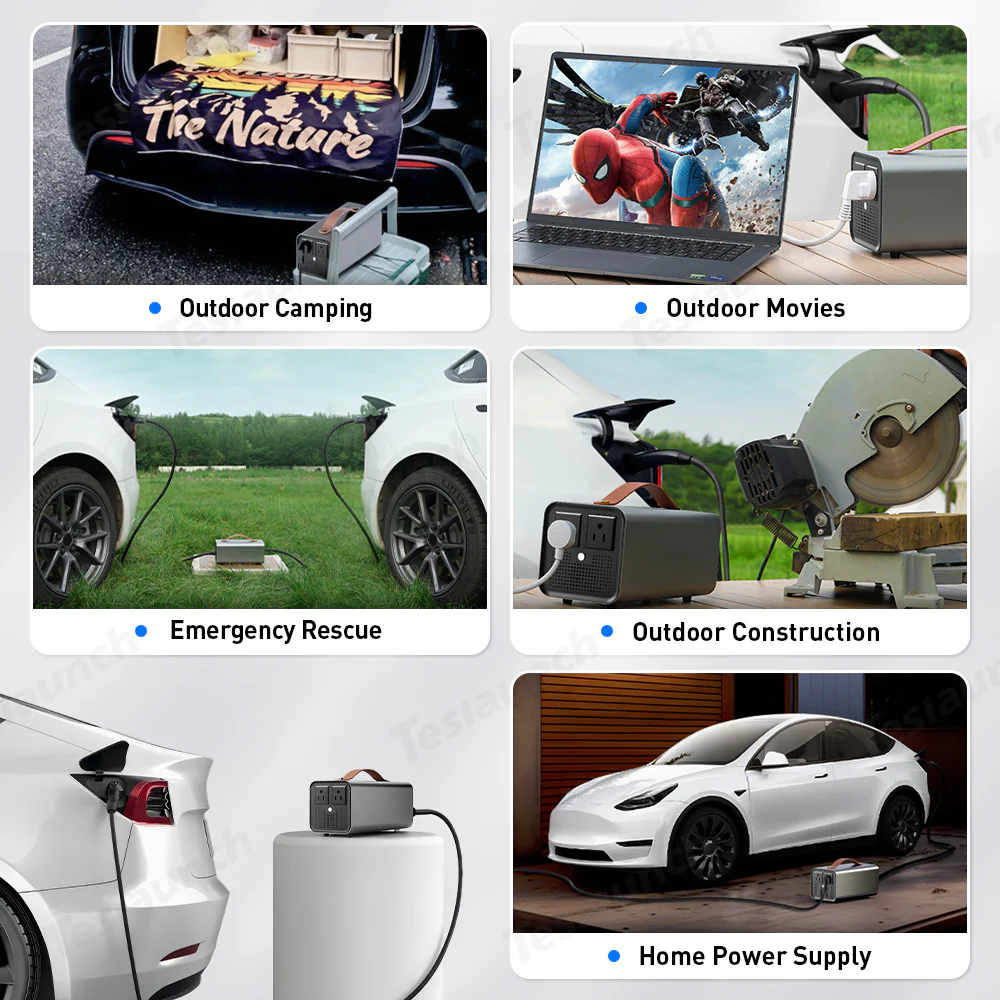Tesla V2L Guide: How to Use It for Camping, Emergency, and Daily Life
In the empty valley, you use your car's power to illuminate cozy string lights, brew your first cup of coffee, and even fully charge your drone's battery to capture the breathtaking scenery at dawn. This isn't a futuristic fantasy; it's a reality made possible by Tesla's Vehicle-to-Load (V2L) technology.

This guide explains Tesla V2L, how it works, and how you can use it in real-world situations such as camping, emergencies, and daily life.
What Is Tesla V2L?
I've mentioned this elsewhere, too, but V2L stands for Vehicle-to-Load, a technology that allows electric vehicles to supply power to external devices.
- Tesla V2L definition: It enables your Tesla to act as a power source, providing up to several kilowatts of electricity.
- How it works: Electricity stored in the car’s battery flows through an inverter and adapter, converting DC power into usable AC power for appliances.
- Models that support V2L: Some Tesla Model Y Juniper (2025+) and Model 3 Highland versions are expected to integrate V2L support, while other models may require third-party adapters.
This makes V2L highly versatile, especially compared to standard charging ports.
Why Tesla V2L Matters
V2L is more than just a tech feature—it solves real problems:
- Emergency power: Keep lights, phones, and medical devices running during blackouts.
- Outdoor convenience: Run camping gear like kettles, portable fridges, or heaters without needing a generator.
- Daily utility: Charge e-bikes, power tools, or laptops anywhere.
For Tesla owners, this means more independence and flexibility.

How to Use Tesla V2L
Step 1: Check Compatibility
Not all Teslas currently have built-in V2L. The feature depends on the model and year:
- Model Y Juniper (2025+): Expected with official V2L support.
- Model 3 Highland: Some trims include V2L.
- Older Tesla models: May require an aftermarket V2L adapter.
Step 2: Get the Right Adapter
Tesla V2L typically requires a V2L adapter to convert the car’s charging port into a usable household outlet.
- Look for adapters certified for 240V / 110V regions.
- Choose one with safety features such as surge protection and auto-shutoff.
Step 3: Connect Devices
Once the adapter is connected, plug your devices into the outlet.
- Recommended for devices under 2–3 kW load (check Tesla’s limits).
- Avoid powering multiple high-wattage appliances simultaneously.
Step 4: Monitor Battery Use
Keep track of remaining battery range, especially during long camping trips or emergencies.
- Use Tesla’s Energy app to check consumption.
- Plan for an extra buffer if you still need to drive afterward.
Using Tesla V2L for Camping
Camping is one of the most popular uses of Tesla V2L. Instead of carrying gas generators, you can rely on your car for clean, quiet power.
Essential Camping Devices Powered by V2L
- Portable fridge/freezer – Keeps food fresh for days.
- Cooking gear – Electric stove, kettle, or coffee machine.
- Lighting – LED lanterns or string lights for ambiance.
- Heaters or fans – Maintain comfort in extreme temperatures.
- Chargers – Phones, tablets, drones, or cameras.
Advantages of V2L Tesla Model Y Camping
- Silent operation – No noisy generators disturbing the environment.
- Eco-friendly – Runs on stored EV power, no fuel required.
- Reliable – Stable energy output for electronics.
- Convenient – No need to carry extra equipment.
Imagine powering a mini projector and speakers for an outdoor movie night in the wilderness—all from your Tesla.
Tesla V2L in Emergencies
A significant advantage of V2L is that you can use your Tesla as a backup power supply during outages.
Critical Devices in Power Outages
- Medical equipment (CPAP machines, oxygen concentrators).
- Home essentials (lamps, Wi-Fi routers, fans).
- Kitchen devices (induction cooktop, small microwave).
- Communication tools (phones, radios, laptops).
Real-World Benefits
- Blackouts: Keep your home running during storms or grid failures.
- Disaster relief: Provide electricity where infrastructure is damaged.
- Mobile charging hub: Help neighbors or family recharge their devices.
While Tesla V2L won’t power an entire house like Vehicle-to-Home (V2H), it’s a practical safety net.

Tesla V2L for Daily Life
Outside of camping and emergencies, Tesla V2L can enhance everyday routines.
Examples of Daily Uses
- Work sites: Power drills, saws, and other tools where outlets aren’t available.
- Outdoor events: Supply energy for speakers, cooking appliances, or decorations.
- Recreational activities: Inflate paddleboards, run a cooler at the beach, or charge e-bikes.
- Road trips: Keep devices fully charged while off-grid.
This flexibility makes owning a Tesla more than just driving—it extends its value into daily living.
Limitations of Tesla V2L
Despite its advantages, there are some limitations:
- Power capacity: Tesla V2L is generally limited to 2–3 kW output. Heavy appliances like air conditioners or ovens may exceed this.
- Battery consumption: Running high-wattage devices reduces driving range.
- Adapter availability: Official Tesla V2L adapters are not yet globally standardized, so aftermarket solutions are standard.
- Regional differences: Voltage standards (110V in North America, 220–240V in Europe/Asia) affect compatibility.
Understanding these constraints helps you plan usage better.
Tesla V2L vs. Other EV Brands
Tesla is not the only automaker offering V2L. Comparing helps highlight its strengths:
- Hyundai Ioniq 5 / Kia EV6: Known for early adoption of V2L with built-in outlets.
- Ford F-150 Lightning: Offers V2L and full Vehicle-to-Home (V2H).
- Tesla: Currently catching up but expected to expand V2L in Model Y and Model 3 updates.
While Tesla’s ecosystem is strong, its V2L rollout is gradual compared to some rivals.
Best Practices for Using Tesla V2L
To get the most out of your Tesla’s V2L capability:
- Plan – Know how much power your devices need.
- Use energy-efficient appliances – Opt for LED lights or low-wattage cookers.
- Monitor battery usage – Avoid depleting the battery too far from charging stations.
- Invest in quality adapters – Prevent overheating and ensure safety.
- Test before relying – Try powering your setup at home before taking it camping.
Conclusion
The Tesla V2L feature transforms your vehicle into more than just transportation. It becomes a mobile energy hub, perfect for camping trips, emergency backup, and daily convenience. While limitations exist, the benefits far outweigh them, especially for Tesla Model Y and Model 3 owners seeking flexibility.
With Tesla V2L adapters and careful planning, you can power almost anything—from a campsite refrigerator to essential medical devices—without the noise and fuel costs of traditional generators. As Tesla expands support across its lineup, V2L will likely become a necessary tool for modern EV owners.
